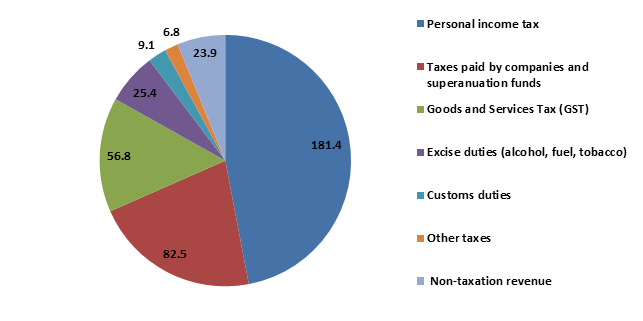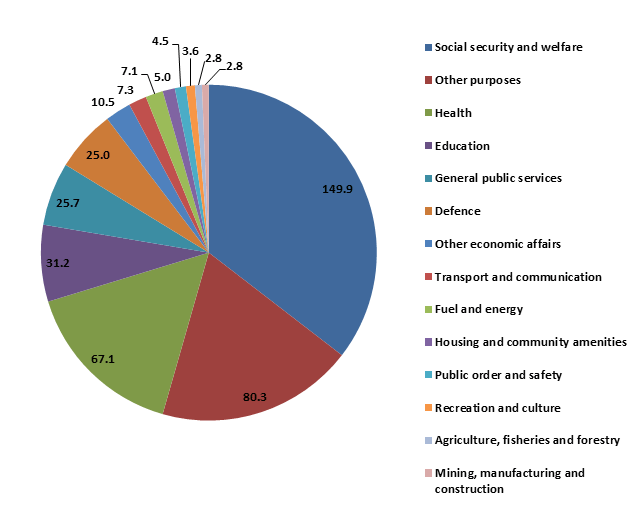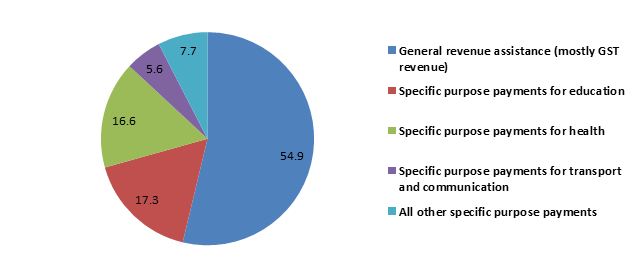11 May 2015
PDF version [313KB]
Daniel Weight and Dinty Mather
Economics Section
The Budget is an
opportunity for the Government to inform the Parliament, and therefore the
broader public, about matters including:
-
the expected performance of the international and Australian
economy
-
the Government’s economic and fiscal strategy
-
specific policy decisions the Government has made.
Budget Night is typically the most important annual policy
statement by the Government.
What happens on Budget Night?
Budget Night is when the Treasurer tables the annual Appropriation
Bills for the forthcoming year in the House of Representatives, and delivers
the second reading speech on those Bills. Since 1994, the Appropriation Bills
have generally been tabled on the second Tuesday in May. The Budget Speech is usually
delivered at 7.30 pm. With the Appropriation Bills, the Treasurer also tables other
Budget related materials.
The Budget Papers and related materials
The main budget materials are the four key Budget Papers:
The Budget Papers include information that is required by
the Charter of Budget Honesty to be presented
with the tabling of the annual Budget. For each portfolio, a Portfolio Budget Statement must also
be tabled in the Parliament.
With the Budget Papers, the Government also publishes:
The Government may also publish and table additional
statements or materials with the Budget Papers. The main type of additional
statement that Governments have tabled is a Ministerial
Statement.
The Budget Papers and related materials are made available
on the internet at www.budget.gov.au
when the Treasurer commences the Budget Speech.
What happens after Budget Night?
On the Thursday immediately following Budget Night, the
Leader of the Opposition will deliver the Opposition’s Budget Reply Speech.
Upon being tabled in the House of Representatives, the particulars
of the expenditure proposed in the Budget are referred to the Senate for
consideration. This enables the Senate to commence its scrutiny of the Budget in
the Senate Estimates process.
Further information
What’s in the
Budget Papers and related materials?
Budget
Speech
The Budget Speech is a copy of the second reading
speech for the Appropriation Bill (No. 1). The Treasurer will use the second
reading speech to state the reasons why the Appropriation Bills should be
passed by the Parliament. Treasurers have used the second reading speech to
update the Parliament about the prevailing economic circumstances, and to announce
important or major policy decisions that the Government has made.
Budget
Overview
The Budget Overview provides a summary of the Budget.
Budget
Paper No. 1: Budget Strategy and Outlook
Budget Paper No. 1 provides high level information on
the overall economic outlook internationally and for Australia, and the
Commonwealth’s fiscal position. It contains:
-
information about the international and domestic economic
outlook, including numerical estimates of key parameters such as gross domestic
product growth, employment, and the consumer price index
-
the Government’s fiscal strategy
-
forecasts of revenues and expenditures and their composition
-
the forecast budget surplus or deficit position
-
information on the assets, liabilities—including contingent
liabilities, or ‘risks’—and debt held or owed by the Commonwealth and
-
historical information about the Commonwealth’s fiscal and debt
position.
Budget Paper No. 1 also contains technical details about
the presentation of the financial information of the Commonwealth, including
how individual entities are classified for accounting purposes, and the budgeted
financial statements for the whole of the Commonwealth Government.
Budget
Paper No. 2: Budget Measures
Budget Paper No. 2 contains information about measures
the Government intends to take to implement its policy decisions. Each measure
is classified according to what aspect of the Commonwealth’s finances it
affects as follows:
-
revenue measures
-
expense measures
-
capital measures.
The description of each measure will have a ‘costing’
attached to it. The costing for a measure is the expected effect of the measure
on the Commonwealth’s finances. It does not include the broader economic effect
of the policy decision on the Australian community. The costing of each measure
only shows the incremental change to the Commonwealth’s finances from that
decision, not the total amount of funding or expenditure related to that policy
area.
Budget
Paper No. 3: Federal Financial Relations
Budget Paper No. 3 contains information about the two
types of payments the Commonwealth makes to the states and territories.
- ‘Specific purpose payments,’ which are monies provided by the
Commonwealth on the condition that the states and territories spend them on
specified purposes such as health, education, or roads, or use them to fund
local governments
- ‘General revenue assistance,’ which are monies provided to the states
or territories without any conditions on how they can be spent.
About one quarter of the monies spent each year by the Commonwealth
are payments to the states and Territories. The main type of general revenue
assistance is the revenue from the Goods and Services Tax.
Budget
Paper No. 4: Agency Resourcing
Budget Paper No. 4 paper mostly deals with appropriations. The introduction provides an
explanation of key concepts used in the Appropriation Bills. The tables provide
information on the individual amounts appropriated to each Commonwealth entity.
Budget Paper No. 4 also contains information on ‘Special Accounts,’
which are amounts of money earmarked for specific activities or purposes.
Portfolio Budget Statements
Each portfolio must prepare a Portfolio Budget Statement. A Portfolio
Budget Statement contains sections for each Commonwealth entity within the
portfolio.
|
Example: The Australian Tax Office (ATO) is an entity within
the Treasury Portfolio. Therefore, the Treasury Portfolio Budget Statement
will include a section relating to the ATO.
|
For each Commonwealth entity, the Portfolio Budget Statement
will show:
-
the budgeted financial statements for the entity
-
each individual ‘outcome’ of
the entity
-
the program or programs
that are aimed at achieving each outcome
-
the total resources available for each Commonwealth entity.
Portfolio Budget Statements are made available on departments’
websites at the same time as the Budget Papers are released.
Ministerial
Statements
The Government may release a Ministerial Statement on any
topic, and in any form, that it chooses. Typically, ministerial statements
group together information related to one theme or issue, and are released
under the name of the relevant portfolio Minister.
Other related reports not released
on Budget Night
Under the Charter of Budget Honesty, additional budget
reports must be publicly released and tabled in Parliament through the year:
-
the Treasurer must release the Mid-Year Economic and Fiscal
Outlook (MYEFO) report within six months of the Budget, or by the end of
January in a given year, whichever is later. The MYEFO report must update any
information that has changed from the Budget during the year
-
the Treasurer must also produce a Final Budget Outcome (FBO)
within three months of the end of each financial year. The FBO must contain the
fiscal outcomes for the Commonwealth for the relevant year.
Every five years the Treasurer must also release and table
in Parliament an Intergenerational Report (IGR). The IGR must assess the
sustainability of current Government policies over 40 years.
Within 10 days of the calling of a general election, the
Secretaries of the Department of Finance and the Treasury must release a Pre-Election
Economic and Fiscal Outlook (PEFO) report. The PEFO must update any
information that has changed from the last budget update.
If additional Appropriation Bills are introduced during the
year, the Government will release a Portfolio Additional Estimates Statement
or a Portfolio Additional Estimates Statement for each portfolio that
has its appropriation changed. These statements will update the information in
the Portfolio Budget Statement.
Further information
Consolidated Revenue Fund and appropriations
Consolidated Revenue Fund
The Consolidated Revenue Fund is established by the Constitution.
All monies received by the Commonwealth must be paid into the Consolidated
Revenue Fund, and may not be withdrawn from the Consolidated Revenue Fund
without an ‘appropriation’ by the Parliament.
Appropriations
The legal authorisation by the Parliament for the release of
monies from the Consolidated Revenue Fund is known as an ‘appropriation,’ and
is required before any monies may be spent by the Government. A request for the
release of monies is made by the introduction of a Bill into the House of
Representatives that ‘proposes an appropriation.’ A Bill that proposes an
appropriation may take two general forms:
-
an ‘annual Appropriation Bill;’ or
-
a Bill that includes a ‘special appropriation’.
Annual
Appropriation Bills
An annual Appropriation Bill will typically provide for
expenditure across a broad range of purposes, but the amount proposed to be
appropriated will be finite. Each year, there are at least three annual
Appropriation Bills:
-
Appropriation Bill (No. 1)
-
Appropriation Bill (No. 2)
-
Appropriation (Parliamentary Departments) Bill.
Appropriation Bill (No. 1) for a given year will propose to
appropriate monies for activities that are part of the ‘ordinary annual
services’ of the Executive Government. Appropriation Bill (No. 2) in a given
year will propose to appropriate monies for the ‘other’ annual services of the
Executive Government. The Senate has different powers
over Appropriation Bills for the ‘ordinary annual services’ of the Executive
Government and Appropriation Bills for the ‘other’ annual services of the
Executive Government. The difference between the two types of Appropriation
Bill, and powers of the Senate over each, are explained in more detail in Odgers’
Australian Senate Practice, Chapter 13, ‘Financial
Legislation’.
The appropriation of monies for the operation of the
Parliament for a given year is proposed in a separate Appropriation
(Parliamentary Departments) Bill, reflecting that the Parliament is separate
from the Executive Government.
Annual Appropriation Bills provide for around 20 per cent of
the Commonwealth’s expenditure each year.
Special appropriations
A Bill may also propose to appropriate an unlimited amount
of money but only make it available for a specific purpose. Such an
appropriation is known as a ‘special appropriation’. Almost all of the
Commonwealth’s substantial expenditure programs are now provided for by special
appropriations; with monies being automatically appropriated from the
Consolidated Revenue Fund where certain criteria are met.
|
Example: Medicare is established under the Health
Insurance Act 1973. Section 125 of that Act appropriates from the Consolidated
Revenue Fund any amount of money required for the payment of Medicare bene
|
To change the amount of money that will be provided by a
special appropriation, the criteria that must be met to use the special
appropriation need to be changed. Where those criteria are set out in
legislation, the Parliament must pass an amendment to that legislation.
|
Example: The Paid Parental Leave Act 2010 says under
what circumstances a person is entitled to parental leave pay. To change the
amount that is appropriated under that Act, an amendment to that Act is
needed to change the eligibility criteria for parental leave pay.
|
Special appropriations provide for around 80 per cent of the
Commonwealth’s expenditure each year.
Further information
Revenue and Expenditures
The Commonwealth’s budget surplus or deficit position is determined
by the balance between receipts and payments. The Commonwealth chooses to
report its budget surplus or deficit in cash
accounting terms through a measure known as the underlying cash balance. Many other
jurisdictions, such as several of the states and territories, use the alternate
accrual accounting measure known as the fiscal balance.
Revenue by type
The revenues of the Commonwealth come mostly from taxes.
Non-taxation revenues include monies from the sale of goods and services,
dividends, and interest. In 2014–15, total Commonwealth revenues were
anticipated to be $385.8 billion. Chart 1 shows the anticipated composition of Commonwealth
revenues for 2014–15.
Chart 1: Government
revenue by type, 2014–15 ($’billion)

Source: 2014–15 Mid-Year
Economic and Fiscal Outlook, Table 3.12.
The amounts received by the Commonwealth as tax receipts
will vary from year to year because of changes occurring in the economy.
|
Example: Companies pay tax on their profits. If company
profits are lower, Commonwealth tax receipts from companies are also likely
to be lower.
|
Changes to revenues because of factors outside the direct
control of the Government are an example of a parameter
variation.
Expenditure by function
In 2014–15, total anticipated expenditure by the
Commonwealth was anticipated to be $422.9 billion. Chart 2 shows the
anticipated Commonwealth expenditure by function for 2014–15.
Chart 2: Expenditure reported by
function, 2014–15 ($’billion)

Source: 2014–15 Mid-Year
Economic and Fiscal Outlook, Table 3.22.
Where a program requires monies to be spent whenever certain
criteria are met, the Government may have no direct control over the total cost
of the program.
|
Example: Unemployment benefits are available to any person who
is ‘unemployed’ within the meaning of the Social Security Act 1991. If
there are more people unemployed in a given year, payments of unemployment
benefits will be greater.
|
Programs that provide monies whenever criteria certain are
met are often known as ‘demand-driven programs’ Changes to the amount expended
under demand-driven programs from year to year are another example of a parameter variation.
‘Other purposes’ expenditure is largely made up of payments
to states and territories. In 2014–15, total payments to the states and territories
were anticipated to be $102.1 billion. The anticipated composition of payments
to the states and territories in 2014–15 is shown at Chart 3 below.
Chart 3: Payments to the states and
territories by function, 2014–15 ($’billion)

Source: 2014–15 Mid-Year
Economic and Fiscal Outlook, Table 3.25.
Further information
Appendix: Key
concepts used in the Budget
Accrual
accounting
Accrual accounting is a method of accounting that records
revenues when they are earned and expenses when they are incurred, regardless
of when cash is received or paid.
Cash
accounting
Cash accounting is a method of accounting that records
receipts and payments of cash when they occur.
Charter
of Budget Honesty
The Charter of Budget Honesty is a set of rules that establish
how the Commonwealth is to manage and report on its fiscal performance. It is a
schedule to the Charter
of Budget Honesty Act 1998.
Departmental and administered
An administered item is an item that a Commonwealth entity
administers of behalf of the Commonwealth as a whole. An administered item may
be an item of expenditure, a revenue, or an asset. A Commonwealth entity has no
discretion about what it can do with an administered item.
Departmental items are expenditure, revenues, or assets
over which a Commonwealth entity has discretion about how it may be used.
Fiscal
balance
Fiscal balance is an accrual accounting measure of the
balance between the revenues and expenses of the Commonwealth.
Non-corporate Commonwealth entities
and corporate Commonwealth entities
Under section 11 of the Public Governance,
Performance and Accountability Act 2013, all Commonwealth entities are
classified as either ‘non-corporate Commonwealth entities’ or ‘corporate
Commonwealth entities.’ Non-corporate Commonwealth entities are legally part of
the Commonwealth, such as departments, or courts and tribunals. Corporate
Commonwealth entities are legally corporations, which give them a separate
legal identity to that of the Commonwealth.
Outcomes and programs
An outcome is the purpose for which monies are
appropriated to non-corporate Commonwealth entities. A program is an activity
that is undertaken by a Commonwealth entity to achieve an ‘outcome.’ For each
outcome, there will be one or more programs.
Parameter
variation
A parameter variation is a change to the revenues or
expenses of the Commonwealth that is outside the direct control of the Government.
Underlying
Cash Balance
Underlying cash balance is a cash accounting measure
of the balance between the receipts and payments of the Commonwealth. It is the
Government’s preferred measure of the surplus or deficit of the Commonwealth.
© Commonwealth of Australia

Creative Commons
With the exception of the Commonwealth Coat of Arms, and to the extent that copyright subsists in a third party, this publication, its logo and front page design are licensed under a Creative Commons Attribution-NonCommercial-NoDerivs 3.0 Australia licence.